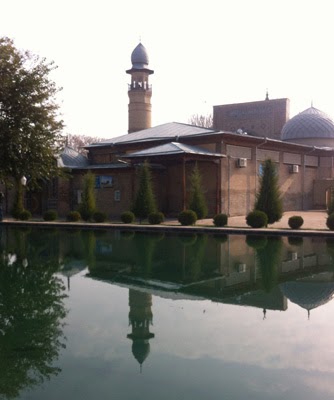 |
| Scene from a puppet play, Tashkent Puppet Theatre |
Here are more suggestions on how to enjoy your time in the city, visiting spots that are not included on an Uzbek Journeys tour.
Tashkent Puppet Theatre
Tashkent's puppet theatre, built in 1979, is a magical place for children and adults. The entrance foyer is a child-size Oriental city with scenes from fairy tales; there is also a puppet museum in the building. Elements of the theatre were commissioned from the best suppliers in the USSR: the chairs in Hungary, the beautiful doors in Moscow. Instead of a bell to call the audience, mechanical figurines holding Uzbek karnay (traditional, long trumpets) announce performances.
The theatre is located at 1 Kosmonavtov Prospect. The nearest metro stop is Kosmonavtov. (If you catch a taxi, it will not be be able to drop you off outside the theatre. Simply get out where the street is blocked and follow the families on foot, about 6 minutes). Performances, in either Uzbek or Russian, are only on Saturdays and Sundays, usually at 11:00 a.m., 1:00 p.m. and 3:00 p.m. Tickets are around US$5 - attending a performance is the only way to see inside this marvellous space. Call the theatre on 256 73 95 to check performance times.
State Museum of History
 |
| State Museum of History, image courtesy Richard Marshall |
It is a sensational example of Soviet cosmic constructivism. Take time to look at the external and internal architectural details.
Today the building is the State Museum of History displaying items from the stone age through modern times. Of particular interest are the pieces collected from the Buddhist sites around Termez. The museum is at 3 Rashidov Avenue in the city centre. It is open daily from 10:00 - 5:00 p.m. and closed Mondays.
Zerlump
Updated 3 May 2016
Zerlump is a small boutique featuring the clothes of Kanishka, a cool Tashkent designer. His t-shirts using Islamic patterns are particularly attractive as are the leather accessories: soft leather bags, passport covers, glasses cases.
 |
| The entrance to Zerlump boutique |
Kanishka has another, larger boutique decorated with Uzbek architectural elements at Usmana Nasir 67, opposite Cafe Fregat. It opens the same hours as Zerlump, except Sundays, however, there is no sign indicating that the house is a boutique. Ring in advance on +998 71 253 1166.
To have a feel for his designs, look at Kanishka's Facebook page.
Holmuradov Designs
While in the mood for shopping, stop by the new boutique of Ulughbek Holmuradov at 59 Babur Street, tel: +998 90 977 8878. Ulughbek is a contemporary jeweller, furniture designer and interior architect. His pieces are irresistible.
 |
| A ring by Ulughbek Holmuradov |
You can swoon over more of his designs on his website. The boutique is open Monday - Saturday 10:00 a.m. - 6:00 p.m.
Tashkent House of Photography
The Tashkent House of Photography (THP) is in an Islamic-designed building, constructed in 1934 specifically as an exhibition hall. The carved portal doors were produced by Uzbek master craftsmen. Since 2005 it has been a dedicated photography space of the Academy of Arts of Uzbekistan supporting the work of budding and well-known photographers.
There are regular exhibitions held of both Uzbek and foreign photographers works. THP is centrally located near the Uzbekistan Hotel at 4 Istikbol Street and is open Tuesday - Sunday from 10:00 a.m. - 5:00 p.m. Alight at metro stop Amir Timur. Call ahead on +99871 233 5168 to check what exhibitions are on.
Bookcafe
 |
| Exterior of Bookcafe |
Abulkasym Madrassah
Built in the mid-19th century, the madrassah, once the stronghold of anti-Tsarist activists, was the scene of the peace treaty signing between Tashkent authorities and Russian General Chernyaev in 1865. In the Soviet period, the building served as accommodation for families from the Russian province of Samara, who were relocated there after the 1920 famine. After the last family left in 1974, the madrassah housed the Tashkent toy factory and gradually fell into disrepair.
After extensive renovations, the madrassah is now a centre of Uzbek applied arts and master craftsmen occupy the former student cells. In particular, the woodcarvers there are exceptional. It is open daily from 10:00 a.m. - 5:00 p.m., however, arriving around 11:30 a.m. should ensure artisans are there.
Abulkasym madrassah is close to Alisher Navoi national park and the parliament building.The nearest metro is Bunyodkur station on the Chilonzor (red) line.
Zenghi-Ata Mausoleum
 |
| Zenghi-Ata complex - garden and minaret |
Kafe - Кафе
This is one of my favourite cafés in Tashkent. Excellent coffee, a variety of cakes and quiches and a cool hangout for Tashkent artists. It is not far from the Fine Arts Museum and near the dance school of Zlotnikov at 23 Shakhrisab St. For directions phone Кафе on +998 94 661 36 37. Usually open from 8:00 a.m. - 10:00 p.m.
Other ideas
On a hot day, take a picnic to the Botanical Gardens. Or you can happily roam around town on foot discovering the fabulous mosaic panels that decorate Tashkent buildings. The Artists Exhibition Hall, decorated in stylised cotton flower motif, may have an interesting exhibition or craft fair. It is located very close to Tsum department store at 40 Rashidov Street and is open daily from 10:00 a.m. - 5:00 p.m. except Sundays and Mondays. For train spotters a visit to the Railway Museum is a must and if you are a football fan, then try to catch a match at the splendid new stadium at Bunyodkor.
Enjoy the city, which I regard as my home away from home.
 |
| Artists Exhibition Hall, Tashkent |
48 Hours in Tashkent
All posts about Tashkent





